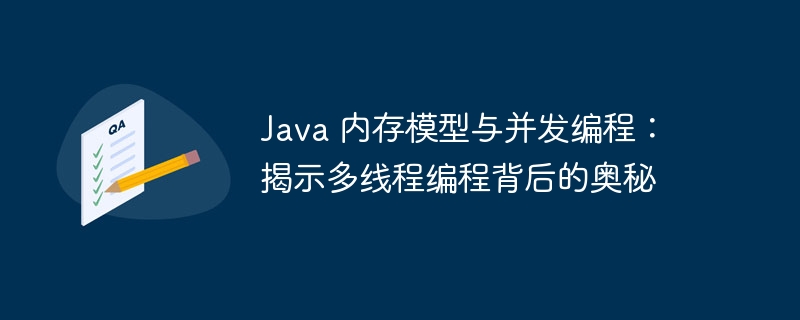Home >Java >javaTutorial >Java Memory Model and Concurrent Programming: Revealing the Mysteries Behind Multi-Threaded Programming
Java Memory Model and Concurrent Programming: Revealing the Mysteries Behind Multi-Threaded Programming
- WBOYforward
- 2024-02-19 12:42:45623browse

Multi-threaded programming has become more complex and challenging in Java due to the Java memory model. PHP editor Banana brings you an in-depth discussion on Java memory model and concurrent programming, revealing the mystery behind multi-threaded programming. In this article, we will explore the basic concepts of the Java memory model, understand important principles in multi-threaded programming, and share some practical tips to help you better understand and apply concurrent programming.
The happens-before relationship defines the causal relationship between two events. If event A happens-before event B, then the modification of shared variables by event B is visible to event A. The happens-before relationship mainly has the following situations:
- Program sequence rules: In a thread, modifications to shared variables by subsequent statements are visible to previous statements.
- Pipe rules: If a thread sends a message to another thread through a pipe (such as a pipe or queue), then the message is visible to the receiving thread.
- Lock Rules: If a thread acquires a lock, modifications to shared variables are visible to other threads.
- volatile variable rules: If a variable is declared volatile, modifications to the variable are visible to all threads.
- Final variable rules: If a variable is declared final, modifications to the variable are visible to all threads.
In addition to the happens-before relationship, JMM also defines the visibility and atomicity of variables:
- Visibility: Visibility means that modifications of shared variables by one thread are visible to other threads. JMM ensures the visibility of variables through happens-before relationships.
- Atomicity: Atomicity means that an operation is either completely executed or not executed at all. JMM ensures the atomicity of variables through locks and volatile variables.
Understanding how the JMM works is critical to understanding and solving concurrent programming problems. By understanding the happens-before relationship, the visibility and atomicity of variables, you can avoid problems such as data inconsistency and deadlock in multi-threaded programming. Here are a few code examples that demonstrate how JMM works:
public class VisibilityDemo {
private static boolean visible = false;
public static void main(String[] args) {
new Thread(() -> {
while (!visible) {
// 等待可见性
}
System.out.println("可见性示例:可见");
}).start();
new Thread(() -> {
try {
Thread.sleep(1000);
} catch (InterruptedException e) {
e.printStackTrace();
}
visible = true;
}).start();
}
}
In this example, two threads run concurrently. The first thread waits for the variable visible to become true, while the second thread sets visible to true after 1 second. When the first thread detects that visible is true, it prints "Visibility Example: Visible".
public class AtomicityDemo {
private static int count = 0;
public static void main(String[] args) {
for (int i = 0; i < 1000; i++) {
new Thread(() -> {
synchronized (AtomicityDemo.class) {
count++;
}
}).start();
}
try {
Thread.sleep(1000);
} catch (InterruptedException e) {
e.printStackTrace();
}
System.out.println("原子性示例:count = " + count);
}
}
In this example, one thousand threads run concurrently, and each thread increments the variable count. Since count is a shared variable, modifications to it are not atomic, so the final output count may be less than or greater than 1000.
The above is the detailed content of Java Memory Model and Concurrent Programming: Revealing the Mysteries Behind Multi-Threaded Programming. For more information, please follow other related articles on the PHP Chinese website!

